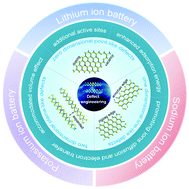Defect engineering of molybdenum disulfide for energy storage
Abstract
Molybdenum disulfide, a typically layered transition metal chalcogenide, is considered one of the promising electrode candidates for next-generation high energy density batteries owing to its tunable physical and chemical properties, low cost, and high specific capacity. Optimizing electrode materials by defect introduction has attracted much attention for the design of high-performance energy devices. A great number of energy storage sites can be exposed by defect construction in electrode materials, which play a significant role in electrochemical reactions. However, there is no systematic review on the defect engineering of molybdenum disulfide materials for the energy storage process. Herein, we summarize and highlight recent advances and investigations on the defect engineering of molybdenum disulfide, with a special focus on applications in lithium-, sodium- and potassium-ion batteries. For a comprehensive illumination of defect effects, the structural defects are classified according to different geometrical dimensionalities, including point-like (vacancies, heteroatoms doping), line-like (edge site), and plane-like (interlayer) defects. Finally, we further discuss the existing challenges and future research prospects for the rational modification and design of high-performance MoS2 electrode materials through defect engineering.

- This article is part of the themed collection: 2021 Materials Chemistry Frontiers Review-type Articles


 Please wait while we load your content...
Please wait while we load your content...